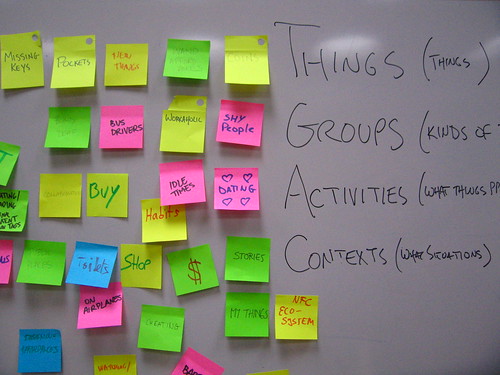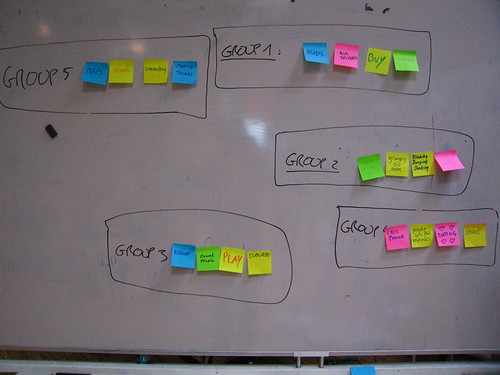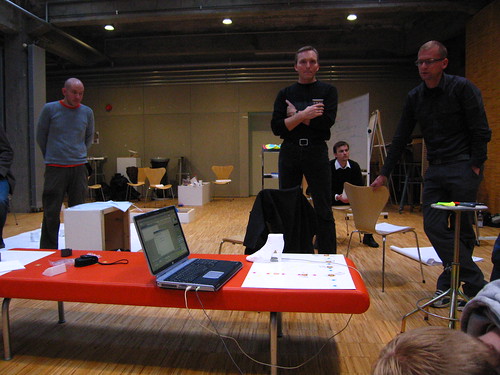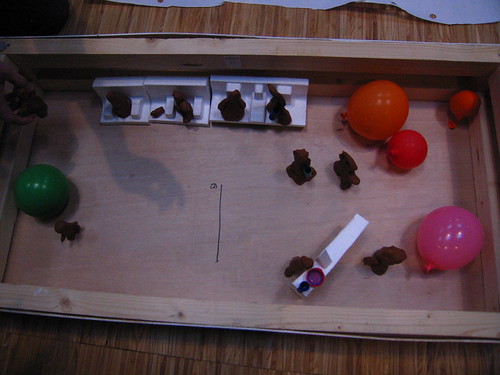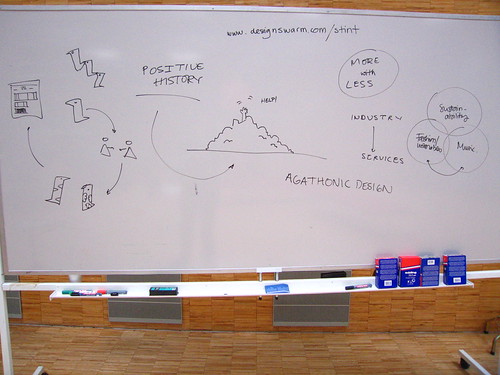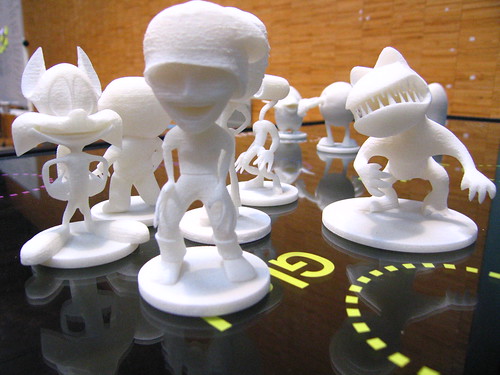
In the middle of the second and final day of the workshop Timo, Nicolas and I organized, and the four working groups are quietly working in groups. Most of the first day was spent with a “5-Minute Madness” introductions from everyone — presenting, with three slides, their POV or perspective on “Touch” semantics as it pertains to tangible networked interaction design. The “Touch” idiom is deliberately loose — we’re not focusing on an instrumentality like RFID, but rather things that could be imagined to have some proximity, swipey, near-field interaction syntax.
Parenthetically, I am now officially a bigger fan of small, hands-on workshops than large, hands-off professional society conferences. I recognize the purpose of the professional conferences as ways to disseminate research, but my (naive? unfounded? newbie?) perspective is that they are now pretty much for funded research projects and corporate labs, of which I am neither. I enjoy going to meet friends and colleagues, but as far as a forum for triggering new perspectives on the research vectors that make me excited, they work pretty much like an expertly applied sleeper hold.
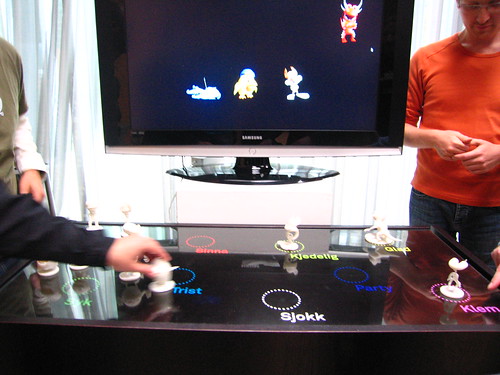
The workshop here, “Touch”, was organized pretty much to foster knotting up a diversity of perspectives on what Touch means as an interaction syntax. There was no specific goal — we didn’t set out with a problem that needed a solution, if such a think exists. We also didn’t set out to define the “Touch” idiom, or what is or isn’t Touch. The perspectives ranged from RFID projects to (my favorite of the weekend) investing “Positive History” into design.
Our approach to running workshops has been different for each workshop we’ve done in this series. In the first at Lift 06, we took a hands-off approach to defining topic areas to work through, and several interesting scenarios were derived. Here you can find a link to the final report. There were ideas revolving largely around the notion that objects can participate in networked social formations in meaningful ways — what are some ways that feel compelling and how are they connected to particular kinds of social practices.
In the second workshop held at EPFL shortly before Reboot, we continued some of the project themes — these were basically offered as silos into which people could divide into group-work. It worked somewhat. Some interesting ideas and and concepts evolved, including MySpaceOfThings and, my own favorite from the “Flickr Camera Blogject” group — Sascha Pohflepp started thinking about his awesome Blind Camera project.
This time, Nicolas, Timo and I pondered how to get group work going. We came up with a rather ad-hoc randomizer. First, we had people fill in post-it notes to fill in four little idioms that we hoped would develop into a conceptual stew for possible group “topics”: Things, Groups, Activities, Contexts — sort of like a Mad Lib approach to coming up with conceptual starting points. A few people then went up to the post-it white board and pulled out one post-it from each silo and put them in a line on another white board. This spelled out some sort of sentence-like brief for the groups.
Wand affordances, grumpy old men, blinking beeping shaking, ???
Cell phone, people with few resources, dating, street
Balloons, Drunk People, Play, Suburbs
These were the little conceptual sentences chosen by the three groups, who then spent the first afternoon and second morning + a little time after lunch creating conceptual prototypes that sort of mapped around these sentences. Some groups spent lots of time swirling in dialogue, whereas others went fairly quickly to physical prototyping. Generally, Timo, Nicolas and I were encouraging conceptualization through physical prototyping as opposed to writing specifications or something like that. I think we’re all fairly keen on the ability to think through making, or sketching in physical form and, as a meta topic, wanted to consider how this could help the workshops.
Moving from there, we had presentations from each group, showing the work they did and how they developed the sentences to concepts. One project showed their project as a theatrical diorama, made from cleverly cut-up polystyrene stuff made to look like a small village and pub and clay people. Another, made a RFID embedded styrofoam shoe to show how paths could be created using near-field interaction, specifically for visually impaired people. The third group created a scenario though a video prototype, explicating how their project would work through a combination of business case description and interactions.
We’ll be collaborating to summarize the workshop more completely in the near future.
Relationship amongst Things & Touch & Blogjects?
The relationship to “things”, networked interactions through circulating conversations and communication, and proximity, touch and near-field is fairly clear to me, but let me just jot it down to help remind myself. It is basically thinking through the kinds of action and ways of circulating meaning that take into account what it is we seem to do in 2nd life worlds anyway, with what is specifically characteristic of 1st life activity — movement, proximity, physical touch, mobility, the ability to generate geographic and physical semantics. Take these characteristics and the meaning-making possibilities for existing social practices that happen in 1st life and laminate that with 2nd life activities, you have a large, messy knot of possibility for near-future kinds of networked, hybrid social practices. Things, I think of as having representations in 1st life that I can Touch and that are Touching, semantically, and Touch the networks by disseminating meaningful data that can become conversational or generators of conversations. 2nd life circulates conversations very well in comparison to older ways of doing such, such as movable type, telegraphs, television, entertainment culture, etc. And the hopeful, aspirational motivation is that when 1st life and 2nd life meet, productive, life-enhancing, sustainable near-future worlds will evolve.
The submissions for the workshop participants is available here. The original call is here.
Technorati Tags: blogjects, proximity, RFID, touch, Internet of Things
